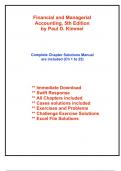Exam (elaborations)
Solutions for Financial and Managerial Accounting, 5th Edition Kimmel (All Chapters included)
- Course
- Institution
This pdf document includes the exercises, problem and case answers.Complete Solutions Manual for Financial and Managerial Accounting, 5th Edition by Paul D. Kimmel, Jerry J. Weygandt, Jill E. Mitchell ; ISBN13: 9781394249077.....(Full Chapters included Chapter 1 to 25)...Chapter 1: Accounting in A...
[Show more]



